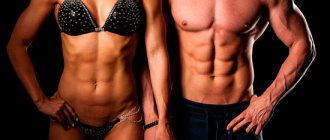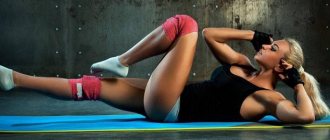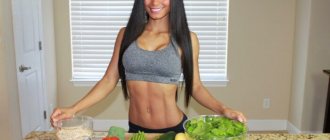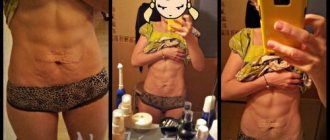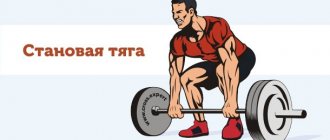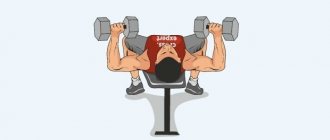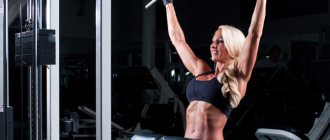The term “body cutting” is used by professional athletes and is a method of maximizing the reduction of fatty tissue in the body, below its own norm, in order to obtain muscle relief.
The result is achieved not only with the help of a special diet, but also with proper training. For people who are not involved in sports professionally and want to acquire permanent sportswear, this method is not entirely suitable. Rather, it will be called weight loss. After all, drying is an extreme and fast way of burning fat, as well as “draining” water, which is achieved for a specific event (competition) and has a temporary effect. But it is impossible to keep the body under constant stress for a long time. This method is not always indicated for a specific organism, as there are a number of limitations and side effects.
I highly recommend watching a video interview with a speaking fitness champion, where she explains in detail what body drying is, how it differs from losing weight, how to do it correctly and much more. And read in more detail how to dry out a girl’s body with examples of a training program and menu for following a diet.
Who needs body drying?
Drying can be useful not only for professionals, but also for overweight people. Only dietary restrictions and physical activity will help reduce subcutaneous fat. In this case, the right approach will help, which is slightly different from a professional one; it can be more related to weight loss. After all, the goal of this method is long-term results, and not achieving the form of one day.
What is the difference between drying the body and losing weight?
When drying, all fats are eliminated from the diet, carbohydrates are reduced to a minimum or eliminated altogether, and salt is removed. You can’t do this for a long time, you can only harm the body and regain twice as much excess weight, since the metabolism of a starving body slows down. Unlike weight loss, which can occur gradually, without great restrictions in the variety of foods and microelements, drying is short-term. When losing weight, fats and carbohydrates are allowed, including fruits.
How to dry your legs, arms, stomach: is local fat burning possible?
If your goal is to burn excess fat only in the abdomen or sides, then know that locally, that is, only in a separate part of the body, this cannot be achieved. With physical activity and diet, fat disappears evenly. Therefore, while the extra centimeters disappear from the stomach, both arms and legs will lose weight. Therefore, you cannot work on just one thing, the approach must be comprehensive, and the training program must include all muscle groups.
During anaerobic and power loads
During training with anaerobic loads, it is not recommended to drink a lot of water, since the heaviness created by the liquid complicates the performance of strength approaches. As you know, performing anaerobic exercise requires maximum concentration, range of motion and expenditure of strength. If you drink a lot of water, it becomes difficult to perform strength exercises. During the training process, it is better to drink purified water in small sips and a little, practically just wetting your lips. At the same time, taking liquid with fast carbohydrates will have a beneficial effect on training. Of course, it is taken during breaks between approaches.
Be sure to drink water before and after anaerobic exercise. After finishing the workout within four hours, you should replenish fluid loss in the body. As you can see, even when drying the body, athletes need to take a sufficient amount of water.
How to start drying
To begin with, it is advisable to write down the initial weight and volumes that will change over time. Thus, you can track the effectiveness of weight loss and volume. Next, figure out your nutrition, prepare a diet of permitted foods for several days in advance. Remove simple carbohydrates from your diet.
It’s better to start eliminating forbidden foods in advance, then it will be easier. Keep a diary of measurements, nutrition and workouts.
Of course, it is advisable to conduct an examination of all organs and systems and see specialists in order to know about problems in advance and not aggravate the disease. It is better to start drying not on your own, but under the supervision of an experienced trainer.
Contraindications
Restrictions to such a diet are violations of the digestive organs and endocrine system. A diet that contains a lot of protein can harm the kidneys, since it is difficult for this organ to remove protein breakdown products - ammonia, in large quantities. Hypertension is also a contraindication for endurance exercise, which is necessary to improve fat burning results. Also, if you have hypertension, the use of special fat burners is prohibited.
Monitoring
The key to success lies in a proper balance between “incoming” and “expending” calories. It is necessary to carry out weighings and measurements at least once a week in order to assess the dynamics and, if necessary, adjust them up or down. It would be great if you also took a photo of your current form once a month, trying to bring the exposure (lighting, pose, degree of muscle tension) as close as possible to the original version. Comparing several photos at different times is the most objective and clear indicator of your progress. In addition, you can take advantage of body composition testing (body bioimpedance analysis), which will give you more information.
Basic rules for drying the body
The main principles when working on muscle relief are:
- exclusion of fats;
- exclusion of glucose, as well as other types of sugar (fructose, lactose);
- frequent meals from 6 to 8 meals;
- full and constant compliance with all nutritional rules, without failures;
- most of the diet consists of protein products;
- constant consumption of large amounts of water;
- exclusion of salt;
- performing physical activity using a special technique.
Entry and exit from drying
You should not start drying abruptly, by limiting all products at once. Eliminate sweets a few weeks beforehand. Then exclude fruits, gradually reduce the amount of complex carbohydrates and fats. At the end of drying, at the exit, gradually add one product every two days, look at the body’s reaction. After drying, carbohydrates may cause severe swelling, so include them in your diet gradually. Starting with slow carbohydrates, then add fruits and dairy products until you return to your normal diet.
Proper nutrition during drying
Nutrition plays a major role in burning subcutaneous fat. An individual diet is selected for each organism. Each person has his own characteristics: body structure (ectomorph, mesomorph, endomorph), and metabolic rate. Some people are allowed to consume more carbohydrates, others only proteins. To do this, you need an experienced consultant who will take into account all the features.
How to calculate the number of calories?
To lose weight with high physical activity, you need to spend from 22 to 26 kilocalories per kilogram of your own weight. Let's take a man weighing 80 kg as an example. We multiply body weight by 22 calories, we get 1760 - the total number of calories per day.
Find out more about how to properly dry the body for men when working on muscle relief.
The required amount of protein is 3 grams, multiply by your own weight, we get 240 g of protein. One gram of protein contains 4 kilocalories. We multiply this amount by 240 g, we get 960 calories from protein. We take a table of products according to the composition of calories and dietary fat. We look at which products and in what quantity contain each substance per 100 g. At the same time, we choose only approved products. We allow 25% of the correct fats from the total amount of calories (1760 multiplied by 0.25), that is, we get 440 calories. Since one gram of this macronutrient contains 9 calories, divide 440 by 9 to get 49 grams of fat. To determine the amount of carbohydrates , we subtract proteins and fats from the total daily calorie content (1760 – 960 – 440 = 360 g of carbohydrates).
In this way, the daily calorie content is calculated, depending on the ratio of proteins, fats and carbohydrates.
The role of carbohydrates and their quantity during drying
The purpose of carbohydrates is to provide the body with energy. Fat burning occurs faster when there is a shortage of energy, which the body begins to produce from subcutaneous fat. The intake of simple carbohydrates during drying leads to its emergency storage in the form of fat, which the body will save for energy. Therefore, any excesses are excluded. Otherwise, drying will not make any sense. For this diet, only complex carbohydrates that take a long time to digest are allowed. They will provide the body with energy, and the fiber contained in complex carbohydrates will ensure the normal functioning of the intestinal tract. But their number is still very limited. You are allowed to consume one gram of carbohydrates per kilogram of weight, unless it is completely carbohydrate-free.
The following carbohydrates are allowed during drying:
- unpolished brown rice;
- vegetables containing fiber and water, without sugar (cucumbers, cabbage, peppers, lettuce, greens).
If you want to eat sweets, you can use a natural sweetener with stevia, which does not contain carbohydrates. It can be added to tea or coffee.
No carbohydrates
This diet consists of consuming foods that contain only protein. Naturally, all carbohydrates are completely excluded.
What to exclude from your diet:
- rice and other cereals;
- any vegetables;
- any fruit;
- sugar and sweeteners (except stevia).
What foods can you eat?
Only low-fat protein foods are allowed:
- chicken fillet (without skin);
- beef, veal;
- rabbit meat;
- quail meat;
- turkey fillet;
- chicken eggs without yolks;
- quail eggs;
- seafood: tuna, hake, pollock, squid, mussels, shrimp, clams;
- drinks: water, green and black tea, coffee.
Fat deficiency
In fact, one of the main disadvantages of drying is precisely the lack of fat. Fats are necessary to nourish cells, therefore, with a low-fat diet, dry skin appears, nails and hair deteriorate. Fats are also necessary to ensure constant contraction of the bile sphincter. Without fats, bile stagnates and increases. In women, the disadvantage of such a restriction is a decrease in the level of estrogen, the main function of which is gestation. When the level of fat in the body is low, the menstrual cycle is disrupted. Therefore, you need to think carefully before you start cutting fat.
Why is it important to drink water?
Water should not be refused under any circumstances. This is ensuring the life of every cell, all organ systems and tissues. Especially during physical activity, dehydration should not be allowed. In addition, water thins the blood, which thickens under stress. You need to consume 30 ml of water for every kg of weight. Therefore, a person weighing 70 kg needs to drink 2100 ml of water per day. When drying, this amount increases to 2500 ml of clean water (tea, coffee are not taken into account). Especially on a diet without salt, a constant supply of water with microelements is necessary.
Glucose regulation
The main feature of drying is the rejection of glucose and any type of sugar. But there are cases of hypoglycemia, a decrease in blood sugar below normal. This causes weakness and dizziness. When such symptoms occur, 25 g of dark chocolate with a cocoa bean content of at least 75% is allowed. It is dark chocolate that has a minimal amount of sugar and a low glycemic index. Glucose will increase in the blood and the condition will immediately improve. But you can’t get carried away with this method, otherwise drying will lose its meaning.
Dairy
Dairy products contain milk sugar (lactose) and when broken down it turns into sucrose. Therefore, it is the same sugar as glucose. Their effect on the body is the same; consumption of any sugar leads to the deposition of excess fat. Therefore, all dairy products are excluded during drying. Moreover, lactose leads to swelling, which is especially undesirable at this time.
Sports supplements
Sports supplements play an important, but not the main role in drying. These are just auxiliary ways to maintain the body's energy. It all depends on nutrition and training, but sometimes supplements speed up the process and make it a little easier.
Protein
Protein is a sports supplement containing pure protein and amino acids. They are not harmful at all (in moderation, since protein affects the excretory organs). Whey isolate, which does not contain sugar, is allowed for drying. Unlike multicomponent proteins, it is completely digestible. Casein and soy are especially not recommended for drying. Protein is just a replacement for eating protein foods. A serving contains about 25 g of pure protein. This is just a way to diversify and supplement your diet.
Creatine
This sports supplement serves to increase muscle strength and volume. The action of creatine is due to the accumulation of water in muscle fibers, which serves to increase strength during exercise. Thus, this additive is not suitable for drying, as it visually increases the volume due to being “flooded” with water. You can’t expect relief on creatine. And during the period of gaining muscle mass it is quite suitable, but only for men.
BCAAs
A supplement that contains essential amino acids (leucine, valine, isoleucine). These amino acids are not produced in the body, so they must be supplied from protein. These amino acids act as a blocker of the catabolic effect (muscle breakdown). If there is a carbohydrate deficiency during drying, this supplement is simply irreplaceable.
L carnitine
This sports supplement is a light and harmless fat burner, as it is found in our body, but is only produced in small quantities. L-carnitine increases body temperature and produces energy from the breakdown of subcutaneous fat. Take half an hour before training. Or in the morning and evening on rest days.
Fat burners and their components
Fat burners with the ECA complex (ephedrine, aspirin, caffeine) are often used. Such components serve to break down fats by increasing energy. The supplement also dulls the feeling of hunger. But the supplements have contraindications; in case of hypertension they are prohibited, as they increase blood pressure.
Menu for the week for proper drying of the body
| Breakfast | Snack | Dinner | Afternoon snack | Dinner | |
| Day 1 | 3 tbsp brown rice, 2 boiled egg whites coffee | Chicken fillet with vegetables | Rice with coleslaw | Seafood salad | Boiled turkey breast, cucumbers |
| Day 2 | Egg white omelette without oil, tea | Salad with egg and shrimp | Rabbit with vegetables | Rice, cucumbers | Baked hake |
| Day 3 | 3 tbsp rice, fresh cucumbers, coffee | Boiled beef, vegetables | Baked tuna, lettuce | Fresh vegetables | Pollock fillet, vegetables |
| Day 4 | Steamed chicken fillet cutlets, rice, egg whites, tea | 5 egg whites, pepper | Rice with asparagus | Eggs, squid, mussels | Turkey fillet with cucumbers |
| Day 5 | Rice, vegetables, coffee | Steamed fish cutlets | Buckwheat with cabbage | Vegetable salad | Steamed tuna, cabbage |
| Day 6 | Steamed fish cutlets, green tea | Rice with seafood | Baked veal, fresh vegetables | Vegetable stew | Baked chicken breasts with vegetables |
| Day 7 | Egg and rice omelette, black tea | Quail eggs with yolk | Lettuce, eggs, mussels | Boiled squid | Beef and fresh vegetable salad |
How to exercise while cutting
Training during the drying period is aimed at developing endurance. Such training should be both strength and aerobic.
Cardio and strength training
When strength training, a superset technique is used - performing exercises one after another without breaks. The number of repetitions in one exercise is 20 – 25. With this training regimen, fats begin to burn due to increased heart rate. Cardio training during the drying period is performed both separately and on days of strength training. The workout should not take much time, since it is important not to provoke the burning of muscle fibers. For cardio, you can use a treadmill, orbitracks, steppers and exercise bikes.
Run
When running, it is important to monitor your heart rate; the comfortable zone for fat burning varies from 120 to 160 beats per minute. Running can be divided into two workouts: 30 minutes in the morning and 30 minutes in the evening. This workout will burn fat, not muscle. It is advisable to run in the morning on an empty stomach; before doing so, it is advisable to take a portion of BCAAs. Training on an empty stomach is good because subcutaneous fat will be immediately broken down for energy.
What affects the need for water?
Each organism is individual and this should be taken into account when considering the question, what affects the need for water? In this case, important points that can affect fluid requirements are:
- A person's lifestyle and age.
- Professional sports.
- Physical and mental stress.
- Human nutrition.
- Drinking alcohol and smoking.
- Pregnancy and lactation period.
- Use of coffee and other drinks.
As we can see, it is difficult to say how much purified water a person should consume. But you need to know when a person drinks insufficient amounts of water, his body volume increases. This occurs as a result of the fact that the cells simply begin to accumulate fluid without knowing when the next supply of water will be.
At the same time, you need to understand that simply filtered water is beneficial for the body, and not boiled water. Coffee and tea do not count towards fluid intake.
